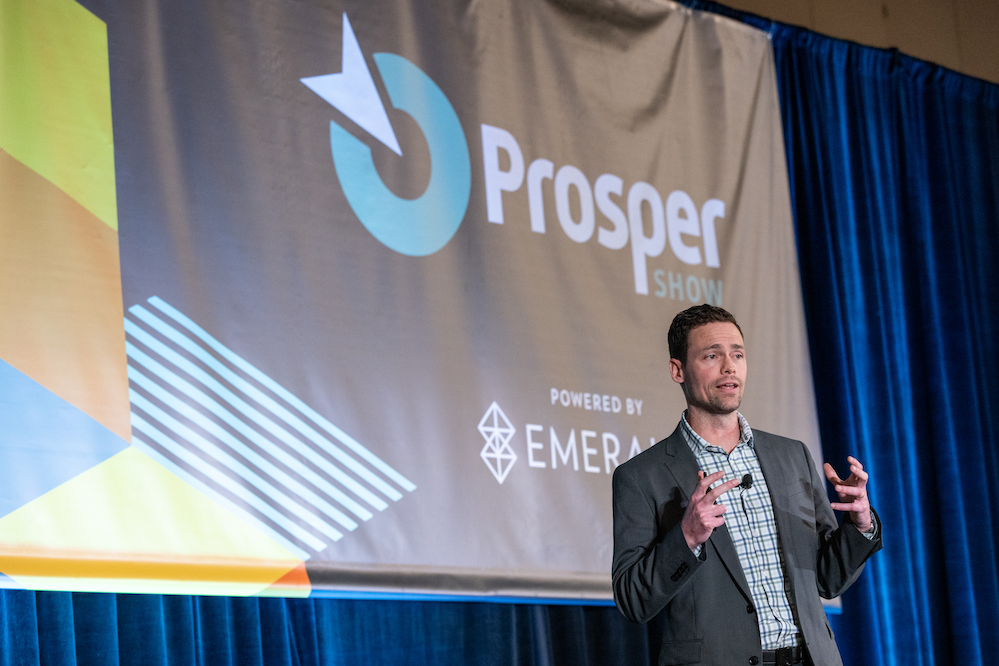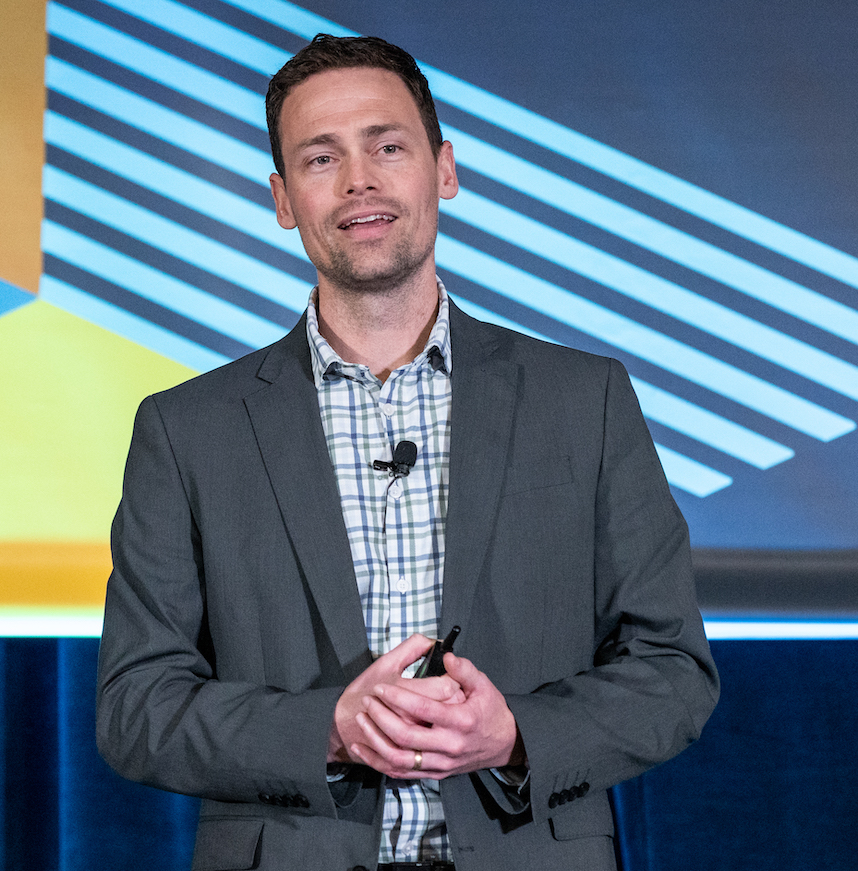March 31, 2025
LAS VEGAS – Bryan Porter (pictured), co-founder of Simple Modern began day two at the Prosper Show with a thoughtful narrative about his journey building Simple Modern, while sharing the core principles that continue to drive the business.
After graduating from the University of Oklahoma College of Business in 2009, Porter joined an eComm startup called QuiBids—a six-year stint that he described as the “perfect experience for what looks like a career in CPG and eCommerce.”
 He worked closely with Mike Beckham during this time, and in 2015 they started Simple Modern, a company which gives away 10% of its profits. The following are extended (and edited) excerpts from Porter’s 45-minute talk—a speech which drew a warm response from Prosper Show attendees.
He worked closely with Mike Beckham during this time, and in 2015 they started Simple Modern, a company which gives away 10% of its profits. The following are extended (and edited) excerpts from Porter’s 45-minute talk—a speech which drew a warm response from Prosper Show attendees.
“We are primarily known for adult drinkware in every size, shape, and color that you can imagine.
“We’ve also gotten into kids’ products—drinkware, backpacks, lunch bags, beach bags. In the beginning our main goal was to sell five million products…eventually getting to 50 million bottles sold.
“We started on Amazon in the marketplace, and eventually worked our way to almost all the major retailers. The one that we have haven’t gotten so far is Dick’s Sporting Goods.
“The first three years we got from zero to $25 million in retail sales. Second three years we achieved $100 million sales, and then the last three years went from $100 million to just under $300 million sales. They are different seasons of the business.
“There were experiences that we had like being very dependent on paid ads to drive our success, and then competition got a little bit stronger. Ads got more expensive, and that strength turned into not really a strength anymore. We have some scar tissue. We have built Simple Modern on organic growth because of experiences like that.
Taking Notice Of Amazon
“We took notice of a company called Amazon that was not only destroying us, but everyone else in E-comm. We thought, ‘Who better to launch a brand on Amazon than three e-commerce analysts’ and we really saw the value. If you can place a product on Amazon, you don’t need to spend a ton of money on advertising…It was really a channel strategy—a belief in ourselves and selling on Amazon.
“We wanted to run a company that was about making everyone’s lives better who came in contact with the company. That’s what we’re passionate about. We started the company with $200,000 and put all that money into as many different products as we could. We didn’t take salaries for the first year. It was really all just pushed into inventory.
“We sold bottles that looked similar to other successful types of drinkware, which makes sense because customers are looking for that. But you do not want to stay in that lane for a long time if you want to create a brand. You want to be known for uniqueness. You don’t want to be known as a dupe.
 Licensing Breakthrough
Licensing Breakthrough
“The next step for us was getting into licensing. Our first step was a local license with the University of Oklahoma, which is the local university. This was something that Mike [co-founder Mike Beckham] pioneered. He probably did the best sales job of his career.
“He took that to Sam’s Club and was able to turn that into full licensing with all of the NCAA and a nationwide program with Sam’s Club. When you have a PO from Sam’s Club, it helps with getting the licenses for the other universities.
“I kicked off a process where we now have gotten into the NBA, NFL, NHL. We’ve been able to take that and show Disney that we’re providing value for all of the fan shop licenses on Amazon. We do the best job of selling drinkware on Amazon. Licensing to this day has been a big driver for us.
“We expanded into different categories on Amazon and we grew the amount of keyword surface area that we could get in front of customers with. So the bottle with a steel lid is the kind of wide-label off-the-shelf product that we sold. The next bottle with a black straw lid we spent two years developing. We made it into the best straw at that time. That was something that we could get IP on and start becoming more unique in our product offering.
Direct To Consumer
“In the distribution phase of our growth, we started to have success with our website. Our playbook for our website until the pandemic was just do what we’re doing on Amazon, and that didn’t work. It was a really bad playbook for us. One of the unlocks was how do we offer value to our customers that we cannot offer on Amazon?
“We have complete control of our website, so let’s get creative. How can we serve our customers better through our website? And how do we build a place where our biggest fans would love to shop?
“That was really the attitude we took towards it. Personalization was a key driver for us. We can laser engrave anything on our products and we have an interface on our website where you can do that. Bundling is an opportunity on our website.
“So you see an explosion of margins whenever you’re putting things into the same box and shipping them together—so we can pass along savings to the customer—and even though we’re a lower margin brand—whenever we get customers to buy more than one thing that’s one way for us to expand our margins—which is really helpful.
 Is Amazon Too Competitive?
Is Amazon Too Competitive?
“Amazon has doubled in revenue since we launched the company. Amazon’s way more competitive now than it used to be. If we tried our strategy now that we tried in 2015—testing five or six products—I’m convinced that they would not all sell through and there would just be more competition. It would make it harder for us to gain traction.
“However, there is always going to be opportunity, and that’s because consumer behavior changes over time. We’re seeing that in drinkware where there’s new brands that pop up, even though it’s ultra competitive.
“You need to have an idea of what is the area of a market that your brand is going to fill. What is your role in that market? For us, it’s been pushing the fashion component. For other brands, it’s undoubtedly other things, but there needs to be a reason why customers are going to choose your products—why you’re going to have an advantage over them.
What About Tariffs?
“That’s a hard question right now, because we don’t really know what to expect. We have a strong partnership with our manufacturer and we value that. We want to view tariffs more as an opportunity. All of our competitors are going through the same thing. There’s data that we’ve seen that during recessions the easiest place to cut is your marketing budget.
“But companies who haven’t cut their marketing budget during a recessionary environment have been seen to gain a lot of market share. We’re going to be more diligent with our marketing, but we want to continue to be aggressive and view this more as an opportunity. We’ve been working with our manufacturer on absorbing some of the tariffs. There’s no doubt that we’re both taking a hit from from both sides. At this point, we’re pretty steadfast in our pricing strategy. We’ve been trying to push our prices up over time anyway.
“We always wanted to be a discount to the premium players, but with new product launches, our goal is to be ten to 20% lower than top price brands. With our new products we’re factoring in tariffs and the amount of marketing that we want to do with our old products. We’re really trying to not increase prices too much for competitive reasons.
